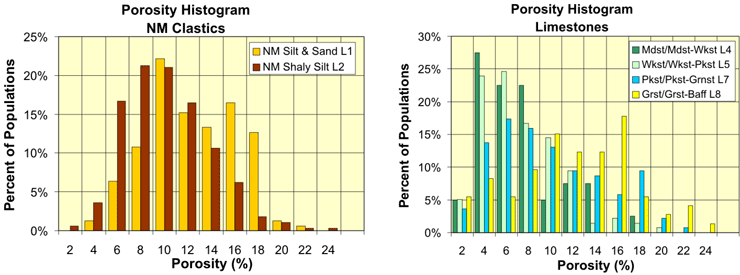Lithofacies and Associated Petrophysical Properties
Lithofacies, Porosity, Permeability
Fundamental to construction of the reservoir geomodel is the
population of cells with the basic lithofacies and their associated petrophysical
properties- porosity, permeability, and fluid saturation. Petrophysical
properties vary between the eight major lithofacies classified (see lower
left). Mean and maximum porosities increase with increasing lithofacies
number for the limestones (mud- to grainstone; histograms below). In situ
(stressed) porosities (![]() ) were
either measured or were calculated from routine helium porosity (
) were
either measured or were calculated from routine helium porosity (![]() routine)
values using the developed correlation:
routine)
values using the developed correlation: ![]() =1.00
=1.00
![]() routine-0.68. Permeability
is a function of several variables including primarily pore throat size,
porosity, grain size and packing (which controls pore body size and distribution),
and bedding architecture. Equations were developed to predict permeability
and water saturation using porosity as the independent variable because
porosity data are the most economic and abundant, and because porosity is
well correlated with the other variables for a given lithofacies.In situ
Klinkenberg (high-pressure gas or liquid-equivalent) gas permeability (k)
exhibits a log-log correlation, or power-law, relationship with porosity
though the relationship changes in some facies at porosities below ~6%.
Each lithofacies exhibits a relatively unique k-f correlation that can be
represented using equations of the form:
routine-0.68. Permeability
is a function of several variables including primarily pore throat size,
porosity, grain size and packing (which controls pore body size and distribution),
and bedding architecture. Equations were developed to predict permeability
and water saturation using porosity as the independent variable because
porosity data are the most economic and abundant, and because porosity is
well correlated with the other variables for a given lithofacies.In situ
Klinkenberg (high-pressure gas or liquid-equivalent) gas permeability (k)
exhibits a log-log correlation, or power-law, relationship with porosity
though the relationship changes in some facies at porosities below ~6%.
Each lithofacies exhibits a relatively unique k-f correlation that can be
represented using equations of the form:
![]()

At porosities below approximately 6% some facies exhibited
higher permeabilities than predicted by the power-law function. For these
facies the relationship between permeability and porosity was best represented
by an equation of the form: logki = A log![]() 3
+ B.Standard error of prediction ranges from a factor of 3.3 to 9.1. At
3
+ B.Standard error of prediction ranges from a factor of 3.3 to 9.1. At
![]() > 6% permeability in grainstone/
bafflestones can be 30X greater than mudstones and >100X greater than
marine siltstones of similar porosity. Differences in permeabilities between
nonmarine silt/ sandstones and shaly siltstones range from 3.3X at 12% porosity
to 7X at 18%. Regression analysis required careful data filtering such as
to removed data from fractured samples. Full-diameter cores frequently exhibit
permeabilities as great as 50X plug permeabilities due to stress relief
fracturing.
> 6% permeability in grainstone/
bafflestones can be 30X greater than mudstones and >100X greater than
marine siltstones of similar porosity. Differences in permeabilities between
nonmarine silt/ sandstones and shaly siltstones range from 3.3X at 12% porosity
to 7X at 18%. Regression analysis required careful data filtering such as
to removed data from fractured samples. Full-diameter cores frequently exhibit
permeabilities as great as 50X plug permeabilities due to stress relief
fracturing.

|
|
e-mail : webadmin@kgs.ku.edu
Last updated May 22, 2003
http://www.kgs.ku.edu/PRS/publication/2003/ofr2003-30/P2-02.html
